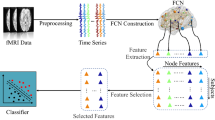Abstract
Function connectivity networks (FCNs) based on resting-state functional magnetic resonance imaging (rs-fMRI) have been used for analysis of brain diseases, such as Alzheimer’s disease (AD) and Attention Deficit Hyperactivity Disorder (ADHD). However, existing studies usually extract meaningful measures (e.g., local clustering coefficients) from FCNs as a feature vector for brain disease classification, and perform vector-based feature selection methods (e.g., t-test) to improve the performance of learning model, thus ignoring important structural information of FCNs. To address this problem, we propose a graph-kernel-based structured feature selection (gk-MTSFS) method for brain disease classification using rs-fMRI data. Different with existing method that focus on vector-based feature selection, our proposed gk-MTSFS method adopts the graph kernel (i.e., kernel constructed on graphs) to preserve the structural information of FCNs, and uses the multi-task learning to explore the complementary information of multi-level thresholded FCNs (i.e., thresholded FCNs with different thresholds). Specifically, in the proposed gk-MTSFS model, we first develop a novel graph-kernel based Laplacian regularizer to preserve the structural information of FCNs. Then, we employ an \(L_{2,1}\)-norm based group sparsity regularizer to joint select a small amount of discriminative features from multi-level FCNs for brain disease classification. Experimental results on both ADNI and ADHD-200 datasets with rs-fMRI data demonstrate the effectiveness of our proposed gk-MTSFS method in rs-fMRI-based brain disease diagnosis.
Access this chapter
Tax calculation will be finalised at checkout
Purchases are for personal use only
Similar content being viewed by others
Notes
- 1.
- 2.
http://fcon_1000.projects.nitrc.org/indi/adhd200/.
- 3.
References
Greicius, M.D., Krasnow, B., Reiss, A.L., Menon, V.: Functional connectivity in the resting brain: a network analysis of the default mode hypothesis. Proc. Natl. Acad. Sci. 100(1), 253–258 (2003)
Lian, C., Liu, M., Zhang, J., Shen, D.: Hierarchical fully convolutional network for joint atrophy localization and Alzheimer’s disease diagnosis using structural MRI. IEEE Trans. Pattern Anal. Mach. Intell. 35, 1798–1828 (2019)
Wang, X., Jiao, Y., Tang, T., Wang, H., Lu, Z.: Altered regional homogeneity patterns in adults with attention-deficit hyperactivity disorder. Eur. J. Radiol. 82(9), 1552–1557 (2013)
Wee, C.Y., et al.: Identification of MCI individuals using structural and functional connectivity networks. NeuroImage 59(3), 2045–2056 (2012)
Liu, F., et al.: Multivariate classification of social anxiety disorder using whole brain functional connectivity. Brain Struct. Funct. 220(1), 101–115 (2015)
Jie, B., Zhang, D., Gao, W., Wang, Q., Wee, C.Y., Shen, D.: Integration of network topological and connectivity properties for neuroimaging classification. IEEE Trans. Biomed. Eng. 61(2), 576–589 (2014)
Jie, B., Zhang, D., Wee, C.Y., Shen, D.: Topological graph kernel on multiple thresholded functional connectivity networks for mild cognitive impairment classification. Hum. Brain Mapp. 35(7), 2876–2897 (2014)
Jie, B., Liu, M., Zhang, D., Shen, D.: Sub-network kernels for measuring similarity of brain connectivity networks in disease diagnosis. IEEE Trans. Image Process. 27(5), 2340–2353 (2018)
Shervashidze, N., Schweitzer, P., Van Leeuwen, E.J., Mehlhorn, K., Borgwardt, K.M.: Weisfeiler-Lehman graph kernels. J. Mach. Learn. Res. 12, 2539–2561 (2011)
Zhang, D., Wang, Y., Zhou, L., Yuan, H., Shen, D.: Multimodal classification of Alzheimer’s disease and mild cognitive impairment. NeuroImage 55(3), 856–867 (2011)
Acknowledgment
This study was supported by NSFC (Nos. 61573023, 61976006, 61703301, and 61902003), Anhui-NSFC (Nos. 1708085MF145 and 1808085MF171), and AHNU-FOYHE (No. xyqZD2017010).
Author information
Authors and Affiliations
Corresponding authors
Editor information
Editors and Affiliations
Rights and permissions
Copyright information
© 2019 Springer Nature Switzerland AG
About this paper
Cite this paper
Wang, Z. et al. (2019). Graph-Kernel-Based Multi-task Structured Feature Selection on Multi-level Functional Connectivity Networks for Brain Disease Classification. In: Zhang, D., Zhou, L., Jie, B., Liu, M. (eds) Graph Learning in Medical Imaging. GLMI 2019. Lecture Notes in Computer Science(), vol 11849. Springer, Cham. https://doi.org/10.1007/978-3-030-35817-4_4
Download citation
DOI: https://doi.org/10.1007/978-3-030-35817-4_4
Published:
Publisher Name: Springer, Cham
Print ISBN: 978-3-030-35816-7
Online ISBN: 978-3-030-35817-4
eBook Packages: Computer ScienceComputer Science (R0)





